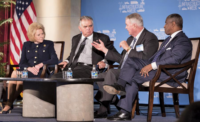
Private financing can help narrow the huge difference between infrastructure’s massive needs and its limited public funding, speakers at a recent conference in Washington, D.C., said. But they also noted that public-private financing vehicles alone won’t close the gap completely.
Speaking at the May 14 meeting, sponsored by McGraw Hill Financial (MHFI), the American Society of Civil Engineers (ASCE) and the Bipartisan Policy Center, ASCE Executive Director Patrick Natale said, “The [infrastructure] shortfall is $1.6 trillion between now and 2020.”
MHFI’s Standard & Poor’s unit (S&P) has estimated there is a $200 billion-a-year gap between public funding on infrastructure and the needs, said Anne Selting, S&P Rating Services’ analytical manager for infrastructure and renewable energy. She added, “We have to look at private investment as an option.”
(MHFI is the corporate parent of ENR and S&P.)
One mechanism is public-private partnerships (P3’s) to design, build, operate and maintain highways or other infrastructure.
Selting said that in the last year or so, S&P had assigned ratings to more than $3 billion in P3-related debt. But she added that the market segment is “still best labeled as nascent.”
Diana Carew, economist at the Progressive Policy Institute, said that just 0.3% of 2013 U.S. road and street construction was privately financed. “There’s humongous room for improvement,” she said.
Carew noted that there are hurdles for P3s, observing that 17 states lack legislation allowing such financial mechanisms for infrastructure.
Federal agencies are working on innovative financing. One program is the Dept. of Transportation’s loan program under the Transportation Infrastructure Finance and Innovation Act, or TIFIA.
The 2012 Moving Ahead for Progress in the 21st Century Act hiked TIFIA’s direct federal funding to $750 million in 2013 and $1 billion last year, from $122 million in 2012. Each direct federal TIFIA dollar can leverage $10 in loan volume. Grants and other funding combine with TIFIA loans to complete projects’ financial packages.
DOT’s chief financial officer, Sylvia Garcia, told conference attendees that the department is “on target” to close 14 TIFIA project agreements this year, up from nine in 2013.
Some in Congress also are exploring ways to attract private dollars for infrastructure. U.S. Sens. Michael Bennet (D-Colo.) and Roy Blunt (R-Tenn.) discussed their bill that would establish a $50-billion “American Infrastructure Fund” that Bennett said could support about $750 billion in loans or local government funding for infrastructure projects.
Companies could purchase bonds backed by the fund by excluding some of their overseas profits from taxation. Their measure, introduced in January, is a companion to a proposal that Rep. John Delaney (D-Md.) introduced in the House in 2013.
A major six-year surface-transportation bill that has started to move in the Senate could be a potential vehicle for the Bennet-Blunt proposal. On May 15, the Environment and Public Works Committee approved a highway-policy section of what would be a larger package, to incluce transit and safety elements. The key missing piece is a yet-to-be-drafted finance title, which would need to provide many billions of dollars to make up for a shortfall in the Highway Trust Fund.
Asked whether he’s considering attaching the infrastructure fund bill to the larger highway bill. Blunt told ENR in an interview, “I think we’d look for any reasonable opportunity to move this bill forward.” He added that the infrastructure fund could be one of the “tools in the toolbox” for infrastructure financing.
Blunt said, “And if the big toolbox turns out to be the moving highway bill, [it would be] a good place to put these tools.”
But he also said that he and Bennet wouldn’t seek to add their proposal to the highway bill “without knowing that [their proposal] was going to be pretty well received on the House side.”


